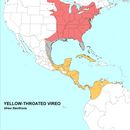en
names in breadcrumbs


A medium-sized (5 inches) vireo, the Yellow-throated Vireo is most easily identified by its yellow breast, gray tail, gray wings with white wing bars, and olive-green back and head with conspicuous yellow eye-rings. This species may be separated from the Philadelphia Vireo (Vireo philadelphicus), which also has a yellow breast, by that species’ plain brownish-gray wings and tail. Male and female Yellow-throated Vireos are similar to one another in all seasons. The Yellow-throated Vireo breeds across much of the eastern United States and southern Canada. Within this range, this species is mostly absent as a breeding bird from northern New England, south Florida, and the western Gulf coast of Louisiana and Texas. Yellow-throated Vireos spend the winter from southern Mexico and the Bahamas south to northern South America. Yellow-throated Vireos breed in a variety of deciduous or mixed deciduous and evergreen woodland habitats. During the winter, this species may be found along the edges of tropical forests. Yellow-throated Vireos primarily eat small insects, but also eat small quantities of fruits and berries during the winter. In appropriate habitat, Yellow-throated Vireos may be seen foraging for food on leaves and branches at middle heights in the canopy. Birdwatchers may also listen for this species’ song, a series of buzzing notes vaguely recalling portions of American Robin songs. Yellow-throated Vireos are primarily active during the day, but, like many migratory songbirds, this species migrates at night.
A medium-sized (5 inches) vireo, the Yellow-throated Vireo is most easily identified by its yellow breast, gray tail, gray wings with white wing bars, and olive-green back and head with conspicuous yellow eye-rings. This species may be separated from the Philadelphia Vireo (Vireo philadelphicus), which also has a yellow breast, by that species’ plain brownish-gray wings and tail. Male and female Yellow-throated Vireos are similar to one another in all seasons. The Yellow-throated Vireo breeds across much of the eastern United States and southern Canada. Within this range, this species is mostly absent as a breeding bird from northern New England, south Florida, and the western Gulf coast of Louisiana and Texas. Yellow-throated Vireos spend the winter from southern Mexico and the Bahamas south to northern South America. Yellow-throated Vireos breed in a variety of deciduous or mixed deciduous and evergreen woodland habitats. During the winter, this species may be found along the edges of tropical forests. Yellow-throated Vireos primarily eat small insects, but also eat small quantities of fruits and berries during the winter. In appropriate habitat, Yellow-throated Vireos may be seen foraging for food on leaves and branches at middle heights in the canopy. Birdwatchers may also listen for this species’ song, a series of buzzing notes vaguely recalling portions of American Robin songs. Yellow-throated Vireos are primarily active during the day, but, like many migratory songbirds, this species migrates at night.
The yellow-throated vireo (Vireo flavifrons) is a small American songbird.
"Vireo" is a Latin word referring to a green migratory bird, perhaps the female golden oriole, possibly the European greenfinch. The specific flavifrons is from the Latin words flavus, "yellow", and frons, "forehead".[2][3]

Adults are mainly olive on the head and upperparts with a yellow throat and white belly; they have dark eyes with yellow "spectacles". The tail and wings are dark with white wing bars. They have thick blue-grey legs and a stout bill.
Measurements:[4]
Their breeding habitat is open deciduous woods in southern Canada and the eastern United States.
These birds migrate to the deep southern United States, Mexico, the Caribbean, and Central America. They are very rare vagrants to western Europe; there is a September 1990 record from Kenidjack Valley in Cornwall, Great Britain, and September 1998 record from Heligoland, a small German archipelago in the German Bight.[5]
They forage for insects high in trees. They also eat berries, especially before migration and in winter when they are occasionally seen feeding on gumbo-limbo (Bursera simaruba) fruit.[6] They make a thick cup nest attached to a fork in a tree branch.